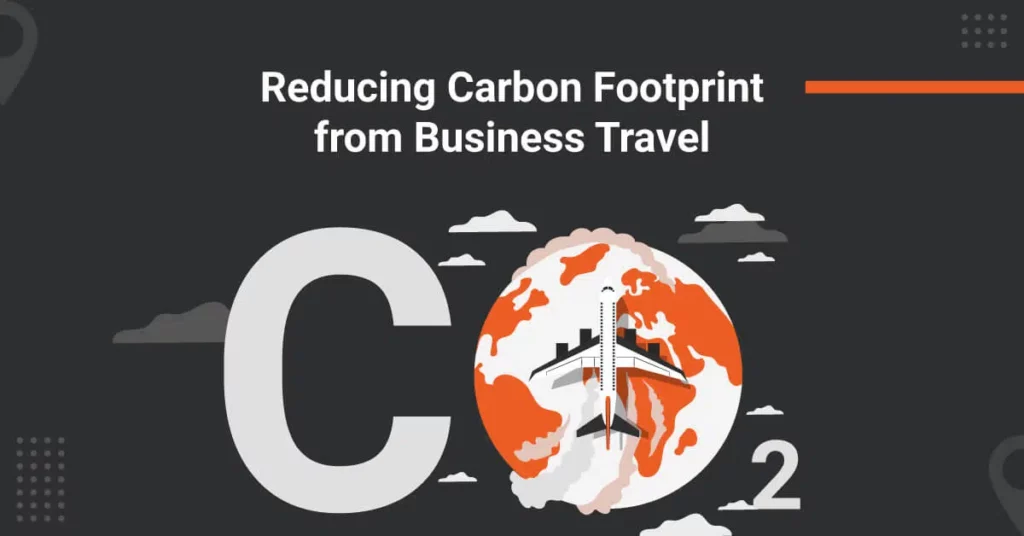
Preserving the environment is everyone’s responsibility. Despite several companies in the world adding ‘environment’ in their CSR, up to 2019, the world saw an increase in the number of carbon emissions year on year. The same was the case with business travel, as it constitutes around 2% of global greenhouse gas emissions.
Then came COVID, and everything changed. It was a blessing in disguise for the environment, with the carbon emission seeing a dip by a record 4.5% in 2020. Business travel also came to a standstill at this point.
This dull phase got companies like Deloitte to rethink their business travel strategies to match a more sustainable model. As the business travel is all set to reboot to its state prior to 2020, companies are making persistent efforts to keep emissions to a minimum.
If you are also one of them, here is what you can do to reduce your business travel carbon footprint.
1. Analyze business travel carbon footprint
The first step to reducing the business travel carbon footprint is to identify the amount of emission caused by your company due to traveling. Although you can’t avoid business travel altogether, companies need to check their carbon emissions constantly so it does not cross the threshold.
You can analyze your company’s carbon footprint by opting for a consultancy firm. However, a more efficient method for calculating carbon footprint is opting for travel management software like ITILITE, which tracks carbon emissions for every trip. Moreover, the software also offers tips and recommendations through enhanced analytics to reduce the same.
2. Choose eco-friendly airlines
According to Guardian, a flight from London to New York city emits an average of 986 kg CO2, which is more than what most people of an entire country produce in a year.
To say that any airline is eco-friendly is far from the truth. But if you compare all the airlines, you can mark some airlines as lesser harmful to the environment. For instance, some airlines, such as Airbus 321 or Boeing 787, are more fuel-efficient. Hence, they burn less fuel and emit lower emissions as compared to some older models.
Moreover, some airlines also try to enforce sustainable practices to reduce the business travel carbon footprint, such as ensuring only recyclable materials, vegetarian food, lighter carts to offload the plane, among others.
You should try to book tickets on these eco-friendly airlines. To check if a flight is eco-friendly, you can go to Google Flights, which shows the carbon emissions of each flight.
3. Prefer economy class
According to Reuters, flying in business class emits three times as much emissions as the economy class.
Let’s face it – if any of us gets the choice of flying business or economy class, what will we choose. Business class, right? However, whenever you are flying business class, you occupy more space than required. Hence, the more business class seats, the fewer seats can be accommodated in an airplane. However, the plane’s fuel consumption remains the same, leading to more carbon emissions per passenger.
When planning business travel, consider booking only economy class seats. Additionally, you can also prefer airlines with fewer or no business class seats at all. Generally, the LCCs (Low-Cost Carriers) do not have business class seats.
4. Avoid layovers
A flight emits more carbon emissions during takeoff and landing of a flight. Hence, when you opt for a flight with multiple stoppages, the entire journey leads to more carbon emissions compared to non-stop flights. Moreover, the total distance of multi-stop flights is more than the non-stop flights, adding to the emissions.
Instruct your travel managers to prefer non-stop flights, even if they cost a bit more. If you are using a travel booking tool for employees, you should draft a travel policy to accommodate the budget of a non-stop flight so that employees can book tickets accordingly.
5. Choose green hotel
Business travel is not only about flights and cabs. The travelers also need accommodation for the period of their stay during the visit. A frequent business traveler stays in hotels for most of the year.
However, it’s strange that although there’s always a buzz around carbon emission due to flights, there is none when it comes to hotels. According to ScienceDirect, international tourist hotels, on average, emit around 28.9 Kg CO2/ person/night. There are multiple factors, such as electricity, air conditioning, refrigeration, and cooking, that cause carbon emissions from a hotel.
Hence, whenever you try to book accommodation for your employee or they book themselves, always prefer a green hotel over others. A green hotel is a hotel that deploys the infrastructure required to sustain an eco-friendly environment, like the installation of solar panels for electricity, heating, and more.
Moreover, a green hotel also implements procedures for recycling and uses only eco-friendly transport.
6. Adopt a sustainable business travel policy
Although travel policy defines the procedures and protocols for business travel, implementing environmental-friendly features in the travel policy itself ensures compliance by the employees.
Try to accommodate features like showing eco-friendly options first, blacklisting flights with the maximum business travel carbon footprint, keeping track of employees’ transportation preferences, offering them rewards for choosing eco-friendly modes of transportation, and more.
7. Educate your employees
Business travel does not only apply to taking flights to the destination. You should also offer some recommendations to employees for a carbon-free trip.
Encourage employees to book accommodations near to the place of work, so they travel less. Moreover, they should prefer eco-friendly vehicles, such as electric cars, for commuting. Also, if the destination is close by, the employees should prefer walking. This will help them improve their health apart from sustaining the environment.
Reduce your Carbon Footprint for a Greener Future
Given the carbon emissions emitted due to business travel, it has now become a necessity for companies to look for more sustainable business travel programs. ITILITE corporate travel management software has a feature that helps companies measure their carbon footprint. You can also order customized reports to check your business travel carbon footprint on a monthly or quarterly basis.
We offer a free demo of ITILITE, so you can use these features yourself and experience their benefits.











